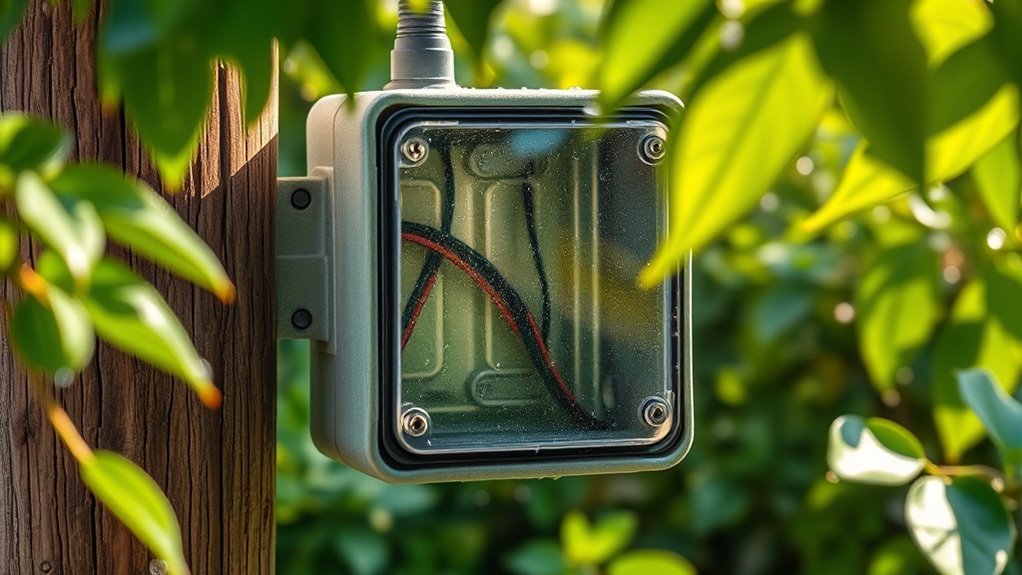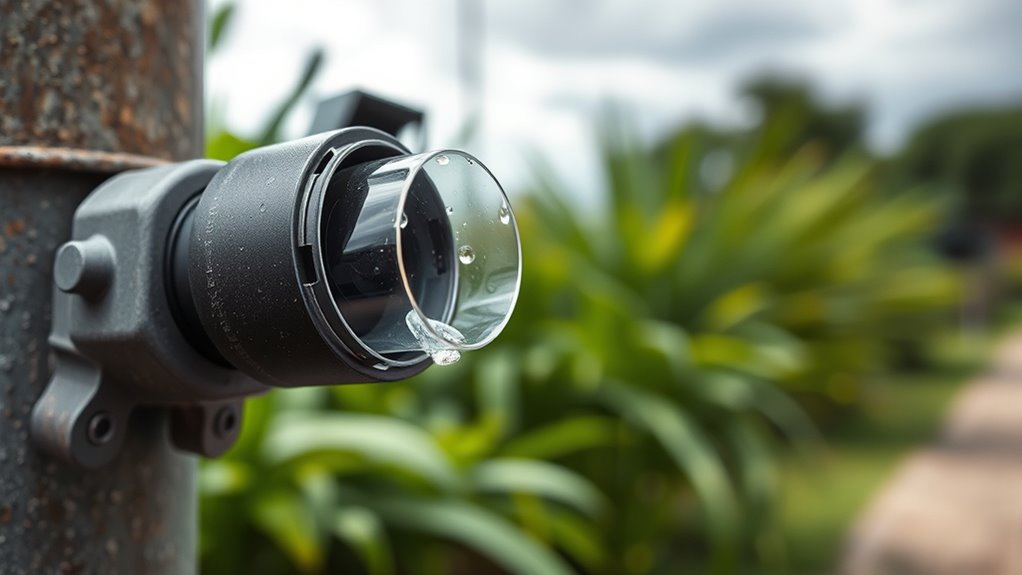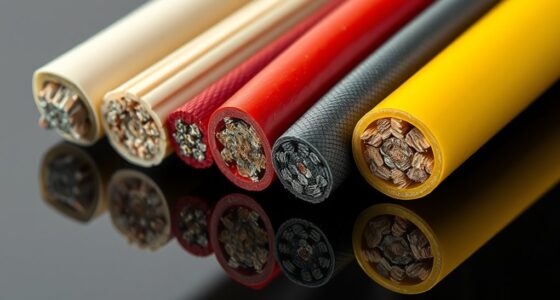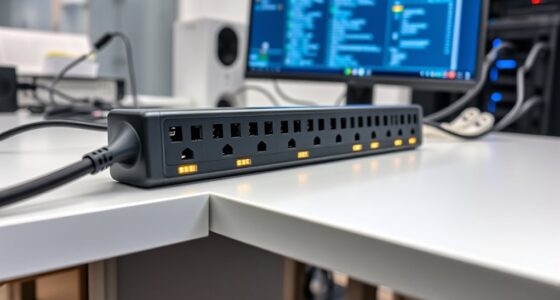Understanding IP ratings helps you choose outdoor cables that can withstand water and dust exposure. An IP rating indicates how well a cable resists environmental factors, with higher ratings offering better protection. For example, IP67 means the cable can handle immersion in water up to 1 meter deep, while IP65 ensures dust resistance and protection against splashes. Knowing these details guarantees your setup stays reliable and durable, so keep exploring to learn how to select the best ratings for your needs.
Key Takeaways
- IP ratings indicate a cable’s protection level against water and dust intrusion, essential for outdoor durability.
- Water resistance, such as IP67, allows cables to withstand immersion in water up to 1 meter for 30 minutes.
- Dust protection ensures cables resist dirt, sand, and debris, preventing damage and system failures.
- Matching IP ratings to environmental conditions reduces maintenance costs and extends cable lifespan.
- Understanding IP ratings helps select suitable cables for outdoor environments, ensuring reliable performance and compliance.

Have you ever wondered how outdoor cables withstand harsh weather conditions? It all comes down to their IP ratings, which indicate how well they resist elements like water and dust. When you see an IP rating, such as IP65 or IP67, you’re fundamentally looking at a standard that tells you the level of protection the cable has against intrusion. This is essential because outdoor environments expose cables to a variety of challenges, from heavy rain to dusty atmospheres. Understanding what these ratings mean helps you choose the right cable for your specific needs, guaranteeing durability and reliable performance over time. Water resistance is a key component of IP ratings. It determines how well the cable can withstand water intrusion, whether from rain, splashes, or even temporary immersion. For example, a cable with an IP67 rating can be submerged in water up to a meter deep for 30 minutes without sustaining damage. This level of protection is fundamental if your outdoor setup involves exposure to rain or accidental water contact. It prevents water from seeping into the cable’s interior, which could otherwise cause short circuits or corrosion, ultimately leading to system failures. When selecting cables, pay attention to the water resistance level specified by the IP rating, especially if your environment is prone to wet conditions. Dust protection is equally important, especially in dusty or sandy environments. Dust particles can infiltrate unprotected cables, causing abrasion, insulation breakdown, or even complete failure over time. IP ratings specify the degree of dust protection, with higher numbers indicating better resistance. For instance, an IP65-rated cable offers complete protection against dust ingress, ensuring that particles don’t interfere with the cable’s operation. This is particularly fundamental in environments like construction sites or areas with high wind-blown debris, where dust can accumulate and cause long-term issues. Choosing cables with high dust protection ratings ensures you minimize maintenance needs and extend the lifespan of your outdoor cabling. In addition, selecting cables with the appropriate IP rating can also prevent unnecessary environmental stress and reduce replacement costs. In essence, understanding the IP rating of outdoor cables helps you match your equipment to the environmental conditions it’ll face. Water resistance and dust protection are foundational aspects of these ratings, safeguarding your investments and maintaining system integrity. By paying attention to these details, you can confidently install cables that stand up to the elements, reducing downtime and avoiding costly repairs. Remember, a high IP rating isn’t just about compliance; it’s about guaranteeing your outdoor infrastructure remains robust and reliable, regardless of weather or environmental challenges.
Frequently Asked Questions
How Do IP Ratings Affect Cable Installation Costs?
IP ratings directly impact your cable installation costs by influencing the choice of cables and necessary protective measures. Higher IP ratings, offering better protection against environmental factors, often increase cost considerations due to specialized materials and more complex installation procedures. You’ll find that installation complexity rises with higher IP ratings, but they ultimately save you money by reducing maintenance and repair needs over time, ensuring reliable outdoor performance.
Are Higher IP Ratings Always Better for Outdoor Environments?
Like a knight’s armor, higher IP ratings offer better water resistance and dust protection, but they’re not always necessary. If your outdoor environment is mild, a lower IP rating suffices and conserves costs. However, in harsh conditions, higher ratings guarantee durability. Evaluate your specific needs—more protection implies higher costs, so choose wisely. In most cases, balancing protection with budget is the smarter move.
Can IP Ratings Change Over Time Due to Wear and Tear?
IP ratings can change over time because of degradation factors like weather exposure, physical damage, or poor maintenance. As these factors wear down the protective seals, the rating might decrease, exposing your cables to more risks. That’s why regular maintenance is essential; it helps identify and address issues early, preserving the integrity of your outdoor cabling and ensuring it continues to meet the required IP standards for protection.
Do IP Ratings Apply to All Types of Outdoor Cables?
Yes, IP ratings apply to most outdoor cables, indicating their water resistance and dust protection levels. You should look for cables with high IP ratings, like IP65 or higher, to guarantee they withstand harsh weather conditions. These ratings help you determine how well the cable resists water ingress and dust intrusion, giving you confidence that your outdoor installation remains protected over time. Always check the specific IP rating for your needs.
How Do IP Ratings Compare to Other Outdoor Protection Standards?
IP ratings focus on protection against dust and water, but other standards like UL, CE, or NEMA also address environmental factors like temperature, UV exposure, and mechanical impact. When choosing outdoor cables, you should compare IP ratings with these compliance standards to guarantee thorough protection. This helps you select cables that withstand specific environmental conditions, giving you confidence in their durability and safety in outdoor settings.
Conclusion
By understanding IP ratings, you guarantee your outdoor cabling stays protected against dust and water, preventing costly failures. For example, if you install a cable with an IP65 rating in a rainy area, you’ll keep moisture out and avoid downtime. Next time you choose outdoor wiring, remember the importance of IP ratings—they’re your first line of defense in harsh environments. Make informed choices and keep your outdoor setups reliable and durable.









